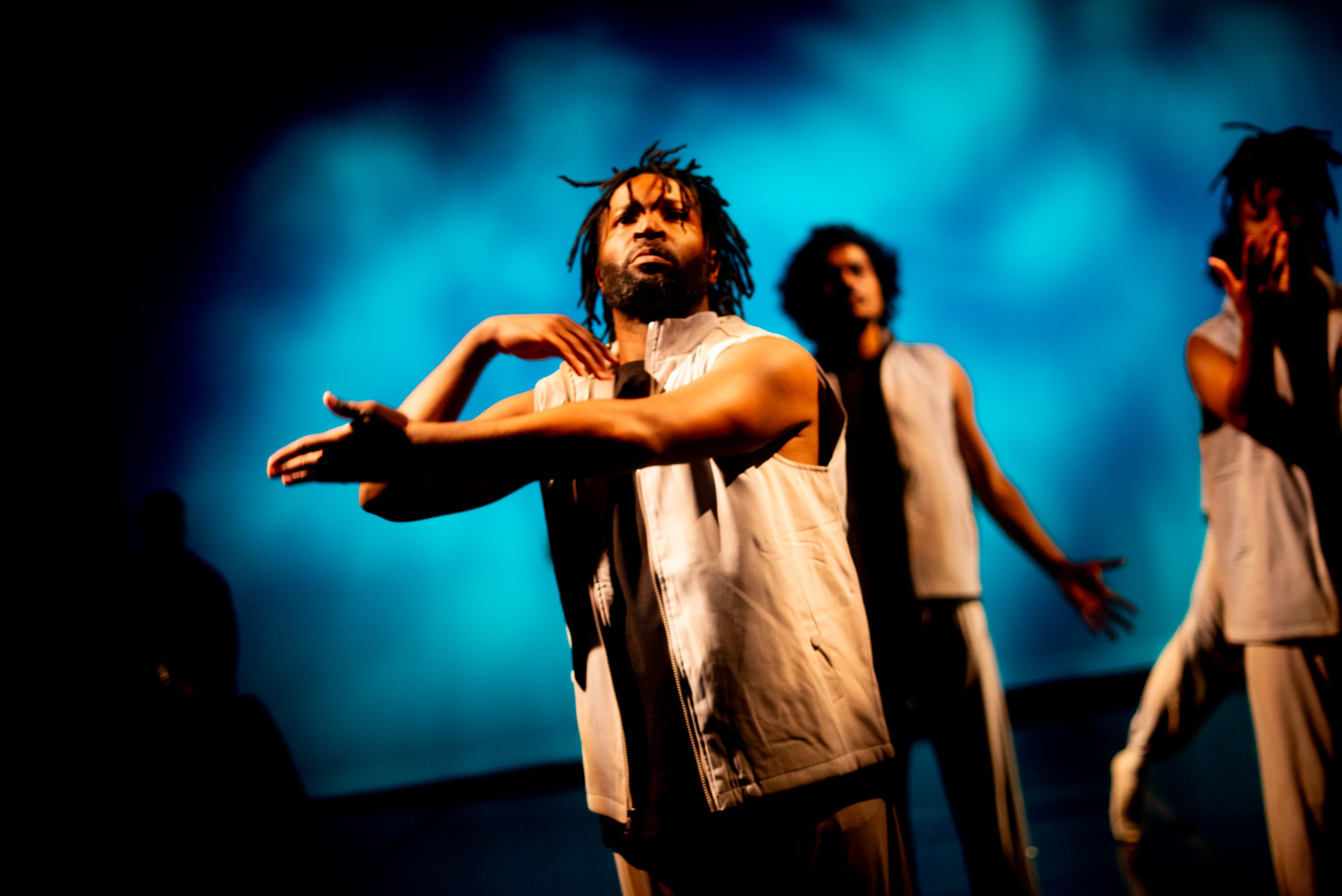
Erik K Raymond Lee, Marc Chappelle, & Ehan Dennis in Raissa Simpson’s House of Rashad, photo by alan kimara dixon
For years Black scholars have been studying the meaning, cultural impact and social tenacity of Black dance. Despite defensible evidence of Black dance culture’s influence on American society – its function to the identifiable continuity for passing on tradition, both classical and contemporary – these findings can oftentimes go relatively underdiscovered by mainstream dance researchers seeking to establish numerical evidence in dance’s economic benefits. Through approaching what extant literature has provided us on Black dance,[1] we can begin to conceptualize how to measure the types of economic impact dance as a whole has on American society – Black dance as a type of calculator. Whereas neuroscientist study of dance dates back around the 1990s, Black dance is concerned with issues like the generational wealth gap which results in turnstile access to funding in the nonprofit arts management sphere. More artists are starting to understand arts administration as a way to navigate budget complexity, how to market themselves, and project management; and out of that is a mere step away to sustaining their creative practices. This article offers considerations for studying the economics of dance through empirical studies on Black dance and numerical data, it identifies current trends, and advocates for the inclusion of Black experience in creative business approaches.
Barrier One – Access to Arts Administration
Access to the arts administration field is a privilege brought on by the ability to access education and raise capital for Black arts administrators and organizations. As mentioned, Black dance demonstrates their success through communal expansion of culture and proves their intrinsic worth through social capital. The National Center for Choreography – Akron (NCCAkron) described creative business as intermingling the humanistic principles found in the choreographic process as a basis for changing how choreographers approach arts administration business. As my group PUSH Dance Company (PUSH) enters into its 20th anniversary, we’re at a crossroads of managing a new dance sanctuary that centers the experiences of global majority artists. For our organization, the combination of Black dance analysis and business frameworks blends well together in a tapestry of wellness and restorative dance practices. This journey combines Afro-wellness, professional development and business led us to an “ask first, then create” process for developing our programs and residencies. By polling the participants who look to our organization for services, we’ve developed a trustworthy relationship in many cases which in turn allows us to bridge the business nonprofit model in tandem with our communities.
Similar to finding arts administration opportunities to NCCAkron’s[2] virtual study groups, I found creative business frameworks through then Executive Director of CounterPulse, Jessica Robinson, the Foundation Center (now Candid) and business class during my undergraduate at SUNY Purchase. Young performing artists are oftentimes encouraged to think of themselves as entrepreneurs. While to be a dancer is to be a business owner, Black dance artists own the distinction for overcoming interpersonal, systemic and familial issues associated with race. Like many Black choreographers, the power of Black collective culture started to transcend into my administrative life as an arts leader. As a continued examination of organizational behavior in the cultural sector, I have found arts administration has become a focus to bridge a siloed world into dance practices. However, as a Black woman of mixed heritage, I have found professional development opportunities for arts leaders a far and few in between.
Both the Arts Administrators of Color (AAC) founded in 2016 and Women of Color in the Arts (WOCA) founded in 2010 are more recent examples of associations formed to take on the issues of diversity in the arts. However, Echoing Green (EG) found that even when Black women leaders in their EG portfolios consistently had the same education level as other arts leaders, they consistently received less funding and financial support than other groups. The paradox facing Black arts leaders is a desire and self-efficacy to sustain Black culture includes enduring discrimination set forth by funding disparities, deeply entrenched post-racial overtones and colorblind mindsets in San Francisco. The San Francisco Bay Area tendencies towards displacement of global majority people raises serious questions about its commitment to cultural diversity.
How to listen: While writing articles such as these or expressing experiences of being Black, my white counterparts will oftentimes perceive this as a bellyaching complaint. To have space to express discontentment on an racial issue is paramount to change, and therefore opens a discourse in order to adequately identify the problem; without an oversimplification or quick fix solutions. Perhaps by measuring bellyaching complaints (polling) of racism in the arts, we can measure these inequalities, draw up visualizations of identifying it as a problem in need of more informed policies. The importance of deeping communicability in order to strip away the discursive greige of manipulative gaslighting can erase the ambiguity around disputes of race’s existence in the arts field, particularly in dance. Much has happened in the new millennium, and the expansion of Black contemporary dance credit in San Francisco goes to Joanna Haigood and Robert Moses. Both choreographers have furthered Black dance in particular by blending topical issues and historical Black figures into their dances. Black choreographers are found or even asked to remain silent about social events concerning Black people. While silence can be a powerful statement of survival for Black artists, we also need spaces to air grievances or just speak in drafts without judgment or punitive retaliation from listeners.
Barrier Two – Overcoming Racial Bias
Perhaps there’s a circular phenomenon for Black dance artists for which the cycle plays out in perpetuity with a lack of finance due to the stigma placed Black entrepreneurs. As producer and founder of Black Choreographers Moving (BCM) Towards the 21st Century, Halifu Osumare gave considerable intellectual and artistic commitment to broadening and futuring the definition of Black dance here in San Francisco and beyond. Despite most Black scholars’ focus on the Deep South and Eastern states, Osumare, a scholar, choreographer and teacher, offers us an extensive portrayal of Black dance in California and Hawaii. In her most recent memoir, Dancing the Afrofuture: Hula, Hip Hop, and the Dunham Legacy (2024),[3] Osumare delves into Black dance as a roadmap of the future. BCM changed the landscape as to what Black dance could potentially be and portrayed as, which was later furthered by Kendra Kimbrough Barnes and Laura Elaine Ellis through the Black Choreographers Festival. That being said, it would be hard to ignore Black dance in California or for that matter, its place on the national stage.
For Black choreographers the intersection between racial bias economics has them financing a type of creative freedom of creativity in tandem with arts administration. Delving into creative administration brought me such joy to study the best practices for developing a mindful nonprofit work. Around 2016, the then executive director of the African American Arts & Cultural Center, Mohammed Bilal invited me to participate in business arts residency. It was there that the director of Cultural Odyssey, Idris Ackamoor asked me to join the African American Theater Alliance for Independence (AATAIN!) whose members included Afrosolo, Lorraine Hansberry Theater, the San Francisco Theater Bay Area Company, African American Shakespeare Company, and PUSH. AATAIN! Additionally, I was fortunate enough to have consultation from Ted Russell, who later went on to the Kenneth Rainin Foundation. Later, the co-interrogators of Dancing Around Race, Gerald Casel, David Herrera, Yayoi Kambara, Bhumi B Patel, and myself began providing racial equity workshops. We wrote our own grants, tracked our own budgets, and collaborated with each other to fortify our entities only because we knew there was no one there to save us.
What’s to understand: To fully understand emergent strategies in motion to determine Black dance’s influence on the study of economics, look no further than techniques to combat the nonprofit model’s alignment with capitalism’s boom and bust economy. Capitalism and other forms of economies (i.e. socialism, communism, etc.) determine how resources are dispersed while simultaneously race amplifies the disquieting magnitude of income inequality. Significant differences remain between capitalism and nonprofits, however the latter is subject to capitalism’s rules, regulations and policies. Despite nonprofits being mission driven, they are still purposely limited in their efforts to carry out those fundamental values by trickle down economics. More specifically, extant data shines a light on how funding is dispersed and to which demographics. As an educator, I’m reminded how the study of economics oftentimes excludes elements of sociology and historical context. The nuances of the socio-historical context in the African diaspora provide implications for the capitulations of 1950’s redevelopment, redlining, suburban mass incarceration, and gentrification. From this perspective Black dance artists have a layered understanding of the racial dilemma found in economic survival of the arts and culture sector.
Barrier Three: Counting Black Dance’s Impact
There’s plenty of informative case studies and recent evaluations such as how only 5.9% of individual donations and 11% of California private foundations awards are distributed to BIPOC-centered organizations Wolf Brown[4]. Why is this amount so low? The obvious answer is because merely 18% of nonprofit organizations in California are BIPOC-led. Why is this number so low? While these numbers may not be completely accurate, it is indefensible that BIPOC-led arts organizations face disparities in funding and representation in the arts management field. Researchers and arts management educators like Antonio Cuyler of the University of Michigan hope to answer questions such as how do Black arts organizations operate. During our move into our BIPOC Sanctuary and new dance home at 447 Minna Street (see image above) in San Francisco, Cuyler gathered a national group of Black arts leaders including myself to study our creative business practice. In his study of the cultural sector, Cuyler posits there’s a better way to understand how funding flows in-and-out of Black arts organizations by focusing on diversity in arts management.
Cuyler measures adversity through quantitative and qualitative research as a means for exploratory study of demographics of the arts workforce. While current funding trends offer white-led arts organizations the ability to learn how to diversify their majority white audiences, Dr. Cuyler is working off the Black arts’ cultural rich inclusiveness. In his book Arts Management, Cultural Policy, & the African Diaspora,[5] Cuyler takes care to dispel the widely circulated myth that Black cultural leaders do not know how to preserve their culture and puts forward a way to count and measure their contributions to the arts ecosystem. At UMich, his Leading & Managing US Global Majority Cultural Organizations class provides placement of the students in the course into internship programs with arts organizations of different disciplines. By bridging theorization of Black dance, an especially strong relationship to practical arts management skills are formed in the program.
What can be done: Antonio Cuyler’s research harkens to a similar method deployed by Harvard Review’s usage of BlackQuantCrit, a qualitative critical theory framework for measuring student outcomes in academia. Hang in there with me for a moment, I know this is dense, but it’s essential to revealing how to tangible measure the impact of Blackness on cultural institutions! Whereas critical race theory or QuantCrit is used to measure general outcomes, it therefore doesn’t fully provide the nuanced scope of how anti-Blackness impacts the gathering of data in the way we find in BlackQuantCrit. What BlackQuantCrit compels us to consider is that while there will be factors other than race for why Black arts organizations struggle, it doesn’t mean anti-Black motive and impacts are absent. The harm done by economics to not account for the social harm done by anti-Blackness results in a suppression of the patterns from colonization and slavery. Along with the perpetual control and divergent resources away from Black communities, the upward mobility of Black enterprise is constantly under harm from racial bias. Modern day researchers and funding institutions are now just recently capturing demographic information which has produced unexpected results such revealing a great deal of numerical evidence of inequitable patterns of racial disparities in the philanthropic system.
Barrier Four: Success Doesn’t Equal Equity
As a global majority arts leader who guides a professional dance group with a twenty year track history of making dances in San Francisco — one of the most economically inequitable cities — I’m uniquely positioned to provide perspective on the economics of dance. In its two decade old existence, PUSH has survived the Great Recession, a global pandemic, post-George Floyd Uprising. We’re currently surviving hyper-gentrification and whatever we can call this post-pandemic recovery. After the George Floyd Uprising, our formalization of a postdisciplinary dialogic process was developed to examine barter economies, municipal policies and a multitude of collective leadership business models. During a good work period, we have 6 weeks to develop a new piece of choreography, otherwise the process of making dances is carried over a two year period, as more resources are gathered. Through Technoculture and Performable Posthumanism, a radical sense of choreographing of citizenship emerges as disruption to how black bodies are perceived on stage. Proverbial wisdom from Black dance scholars and authors offered stepping stones to navigating San Francisco’s constant and ergo instrumental anti-Black aggression. Over the past five years, we’ve raised over $850,000 in funding with $250,000 of those dollars going to emerging artists to produce their own art. With a mantra “Art to the People,” a tagline yielding free dance classes for children, affordable open classes, small grant programs and artist residencies.
How to identify patterns: During an arts town hall meeting in 2010, the then mayor of San Francisco, Ed Lee made a major revelation to the arts community about a plan to invite big tech giants like Twitter and Google to the financially congealed city by waiving many of their taxes. Lee’s reasoning at that time acknowledged how tech workers wanted to live in San Francisco due to its vibrant and diverse arts community. The address came with many promises to hire those who already lived in the city and how tech workers would patronize local businesses, additionally how the artist’s economy would benefit from those affluent donors. The declaration had all the dubious makings of an eminent plan already in motion – if you have the financial means to participate in society or Pay-to-Play strategy – with backroom deals siloed behind closed doors. Lee didn’t invent gentrification but the decision on tax breaks to private companies set the stage for solidifying its infrastructure. At a time when San Francisco was in a type of post-recession era, it was clear how the appeal didn’t sit well with many in the audience. As one attendee questioned, “If they want to be here so badly, why don’t they pay their taxes?”
Perspectives on Financing Your Own Future
Gentrification doesn’t work due to its industrious nature to produce income inequality. Over ten years later, the influx of affluent households alongside the monolithic tech worker culture placed metropolitan areas in a state of surest due to neoliberal trickle-down policies. Nonprofits are designed to support the arts and cultural heritage with the caveat to not express political ideology, proselytize religion, and among other rules. After the 2024 Election, Silicon Valley took its turn in Washington D.C. with the neoliberal privatization of government and what was to be the rollback of DEI, Women’s Rights and Civil Rights. The clear backstepping of racial reckoning and systems change is a pattern of reduction, which primarily affects Black creators. That is to say, we can measure equity in the arts as opposed to struggling to understand how economic policies affect vulnerable populations. What if we could better understand the generational wealth gap the same way we track the ephemeralness of dance?
What I propose in this article is without vanity but in a manner to shine a light on understanding of how Black choreographers may develop their work in California’s economic climate. While adapting to changing economic times is worthwhile for survival, I find that the coming problem of tokenization with the impossibility of assimilation leaves myself and other Black choreographers on the periphery of arts administration; without the throughline to human dignity or monetary gain. As an arts administrator, educator, and Black choreographer, I tend to fall into the trap of trusting the nonprofit arts model as a plausible way to create my art. When intersectionality of Black entrepreneurship and choreography intermingles with historical theorization I find there’s a type of daily racial economic embodiment. I think we are incorporating colorblind approaches to economics – intentional or not – and other bootstrap theories that place the onus on Black people to pull themselves out of their own subjugation. However, the paradox of race and economics is that financial measures are divided along racial lines. In order to set the stage for liberation, I believe that access to arts administration, overcoming racial bias, measuring adversity, and understanding token phases are debiasing techniques needed to go beyond the promises of diversity, equity and inclusion.
[1] Katrina Hazzard-Gordon, Afro-American core culture social dance: An examination of four aspects of meaning, Dance Research Journal, 1983
Thomas F. Defrantz, “The Black Beat Made Visible: Hip Hop Dance and Body Power,” Of the Presence of the Body: Essays on Dance and Performance Theory. Ed. Andre Lepecki. Middletown, CT: Wesleyan University Press, 2004.
Brenda Dixon Gottschild, The Black Dancing Body: A Geography From Coon to Cool, Springer, 2003
[2] Artists On Creative Administration: A Workbook from the National Center for Choreography, University of Akron, 2004
[3] Halifu Osumare, Dancing the Afrofuture: Hula, Hip Hop, and the Dunham Legacy, University of Florida, 2024
[4] John Carnwath, Alan Brown, Salvador Acevedo, Anh Thang Dao-Shah, Shalini Agrawal, Wolf Brown Report, California Arts Council: Grantmaking Evaluation, 2023
[5] Antonio Cuyler, Arts Management, Cultural Policy, & The African Diaspora, Palgrave MacMillan, 2022
This article appears in the Spring 2025 issue of In Dance.


